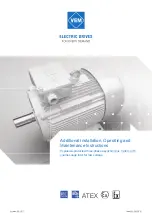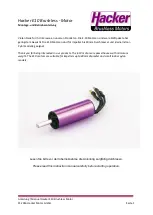
Starting
1. Check that prop bolts are tight and spinner is secure.
2. Make sure the starting area is free of dirt, sand, gravel, or other loose debris
3. Turn on the radio system and check the throttle operation and position.
4. Have someone (with eye protection) firmly hold the plane.
5. Close the choke completely.
6. Open the throttle to approximately 1/4 position.
7. Turn on the ignition. ALWAYS BE PREPARED FOR THE MOTOR TO START ON ANY FLIP OF
THE PROP, whether the ignition switch is on or off!
8. Always wear a heavy leather glove when starting the motor.
9. Give the prop a quick, firm, flip counter clockwise. Follow through quickly as you flip the prop so
your hand is out of the propeller's path. Repeat until the motor fires or “pops”.
10. Open the choke.
11. Set throttle to idle position. (carb butterfly plates slightly open)
12. Flip the prop again until the motor runs.
13. Let the motor warm up for 15 or 20 seconds before advancing the throttle.
Needle Adjustments
•
The needle farthest from the motor is the “High RPM” needle. The needle closest to motor is the
“Low RPM” needle. Turning the needles clockwise “leans” the fuel mixture. Turning the needles
counter-clockwise “richens” the fuel mixture.
•
Settings will vary with altitude, temperature, humidity, fuel, carb variances, etc. A general starting
point is: 1 3/4 open on the Low needle, 2 1/8 turns open on the High needle.
•
Adjusting either needle can have a slight effect on the other. Example: leaning the low needle can
"slightly" lean the high range.
•
Adjust the High RPM needle to peak rpm. A tachometer is a great help, but remember that the RPM
may drop a little bit after every start due to residual heat build up. Don’t lean the mixture any more
than necessary. If the rpm steadily drops at full throttle or fades on long vertical maneuvers, the
motor is too lean and is over heating.
•
Adjust the Low RPM needle until you achieve a smooth idle and a reliable transition to high throttle.
Generally if the motor “stutters” or “coughs” in the mid range or when the throttle is advanced, the
low end needle is too rich and possibly even the high end needle. If the motor dies quickly, the low
end is probably lean.
•
Don't set the needles overly rich to protect the engine. Operating the motor overly rich not only
reduces power, it creates other problems such as poor transition, pre-mature carbon build up, fouled
plugs, excessive exhaust residue, sticking rings, and overall rough running.
Trouble Shooting
Motor won't start
•
Check battery voltage ( should be 5.0+ volts) and all ignition connections, wiring and switches. Wires
can break from vibration near connectors. Check and/or swap out regulator.
•
Check tank venting, clunk position, and fuel flow.
•
Does fuel move towards the carbs when the prop is flipped?
•
If a carb isn’t priming, is the choke plate closing completely? Is the carb or carb mount loose
causing an air leak? Look for fuel seepage.
•
Is throttle set at idle or slightly higher after motor “pops” and choke is opened?
(Cont'd)
5



























